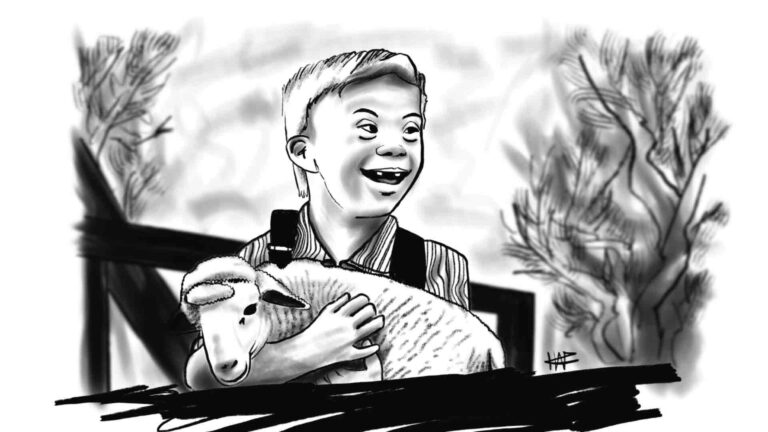Few American scientists achieved fame and fortune as quickly as Dr. Stephen Jay Gould (1941-2002), and few scientists aroused such mixed emotions among their colleagues and the public. Many of his colleagues never forgave him for so spectacularly aiding the creationist cause.
As an ardent evolutionist, he certainly had no intention of providing help of any sort to Christians. Dr. Gould complained that creationists exploited his views in an unethical way – that they latter gleefully reported Gould’s critical views on the fossil record – that the supposed transitional fossils largely didn’t exist – but ignored his support for evolution. He was annoyed that they thought it perfectly reasonable to agree with Gould about the nature of the evidence without subscribing to his assessment of the significance of the evidence. As far as Gould was concerned, his opinions were a package deal: accept all or none.
Of course it wasn’t just creationists who latched on to just a portion of Gould’s opinions. Some of his fellow secular scientists would quote his remarks about the evolution being a fact, while rejecting Gould’s conclusions about the fossil record.
Suffice it to say then, that Gould was a controversial character in many circles. He was, however, certainly the best known paleontologist of his time, and probably the most popular scientist with the public.
Um…you’re wrong!
In his youth, Gould found deep inspiration for his studies in the concept of evolution. He confided in 1980: “I well remember how the synthetic theory [neo-Darwinism] beguiled me with its unifying power when I was a graduate student in the mid-1960s.”
There was a difference, however, between Gould and other similarly-motivated students in American universities. He and fellow student Niles Eldredge were unafraid to speak their minds. If the emperor had no clothes, then they would say so.
And they did! They published an article in 1972 which famously proclaimed that the fossil record did not say what evolutionists were claiming it indicated. The secular scientists of the day claimed that the fossil record demonstrated gradual change over long periods of time. Eldredge and Gould, the cocky young upstarts, said “not so.”
Born in New York city in 1941, Gould received his doctorate in paleontology from Columbia University in 1967. He then went on to teach at equally prestigious Harvard University. He became a full professor there at the tender age of 33 and remained on the staff for the rest of his life. Among his extracurricular activities which contributed to his fame, he wrote monthly vignettes on science for Natural History Magazine. He began this in 1974 and continued for 300 consecutive issues, ending in 2001.
Among his early pieces in Natural History was “Evolution’s Erratic Pace.” In it he described for public consumption views which he previously communicated in the technical literature. Concerning these views, creationists were ecstatic. Here was an evolutionist drawing the same conclusions they were. The public might be suspicious of people with a vested interest – Christian creationists – but Gould had no particular reason to differ from the establishment view.
But differ he did. Thus Gould wrote:
“The extreme rarity of transitional forms in the fossil record persists as the trade secret of paleontology. The evolutionary trees that adorn our textbooks have data only at the tips and nodes of their branches; the rest is inference, however reasonable, not the evidence of the fossils” (Natural History May 1977 p. 14).
“Punk eek”
Traditional evolutionists or “gradualists,” claimed to find fossils in-between one group and another, or in other words, fossils of transitional stages, as one animal evolves into another. But that simply wasn’t the way it really was, according to Gould. He said that to make their claims these people had to reject “literal appearance and common sense” in order to discover the supposed “underlying reality” of transitional fossils and evolution (Natural History p. 12)
Gould did not go so far as to conclude that “sudden appearance” of creatures in the fossil record suggested the occurrence of a supernatural event such as a worldwide flood. Instead he and Eldredge proposed punctuated equilibria or “punk eek” for short – the idea that evolution proceeds in fits and starts and that the actual process of change is so fast that the transitional stages – the in-between organisms – will hardly ever be preserved as fossils.
Many people wonder why, if Gould’s interpretation of the fossil record is correct, did establishment scientists of the time represent it as otherwise. Gould himself commented on this in his 1995 book Dinosaur in a Haystack (consisting of articles reprinted from Natural History). On page 127 he noted:
“Before Niles Eldredge and I proposed the theory of punctuated equilibrium in 1972, the stasis or nonchange of most fossil species during their lengthy geological spans had been tacitly acknowledged by all paleontologists, but almost never studied explicitly because prevailing theory treated stasis as uninteresting nonevidence for nonevolution.”
Creationists, for their part, reinterpreted such remarks to mean “interesting evidence for the creation model.” Gould, indeed, reiterated his view that the fossil record was an embarrassing “manifestation of nothing (that is, nonevolution)” (p. 128). Supporters of the alternative model (creation) insisted that data suggesting an evolutionary “nothing” actually fit the creation model.
As of 1985, Gould considered that his greatest professional achievement was documenting the frequency and importance of stasis (Paleobiology 11 # 1 p. 6). There is no doubt that this and other views of Stephen Gould had a marked effect on the public. This was particularly so because his writing style was witty, clear and full of unexpected cultural references. He was extremely well read, a fan of Gilbert and Sullivan’s English nineteenth century satirical light opera (a particular favorite of mine too), and also an avid baseball fan. Naturally during all those years of writing, Gould communicated not only his views on nature, but his entire philosophy.
Gould’s philosophy
Gould was a materialist. That means he believe that matter was all there is, and there is no spiritual realm. And he did not believe in God. This was the reason he was so taken with Darwinism. As Gould remarked in 1977 in another popular book, Ever since Darwin, Darwin argued that evolution exhibits “no purpose,” “no direction” and it is “rigidly materialistic (and basically atheistic).”
Since he was an atheist, one may well wonder whether Gould believed in an ultimate reality or in truth. The answer seems to be “perhaps.” Indeed in Dinosaur in a Haystack he remarked “I do not think that ‘right’ and ‘wrong’ are good categories for assessing mental models of external reality – for models in science are judged as useful or detrimental, not true or false” (p. 96).
Moreover he clearly recognized that data themselves do not force a given conclusion. Rather he said, we often have to adopt a new view or paradigm before we will see the significance of certain data. Thus it was only after the creation model was largely rejected and the evolution model adopted that scientists could see evolution in nature. He thus stated in Dinosaur in a Haystack:
“Correction of error cannot always arise from new discovery within an accepted conceptual system. Sometimes the theory has to crumble first, and a new framework be adopted, before the crucial facts can be seen at all. We needed to suspect that evolution might be true in order to see variation among individuals in a population as the dynamic stuff of historical change, and not as trivial or accidental deviation from a created archetype” (p. 127).
While Gould, time and time again, declared that it is possible to interpret the same data in different ways depending upon our preconceptions, nevertheless he insisted (e.g. Full House 1996 p. 19) that the creation account represents myth which is “not an option for thinking people, who must respect the basic factuality of both time’s immensity and evolution’s veracity.” Since veracity means truthfulness, it appears that he equated evolution with truth.
More tolerant than some
Stephen Jay Gould died May 20, 2002 at age 60. He had been diagnosed with a rare and deadly cancer at age 40 in July 1982. Concerning that event, he wrote in Discover (June 1985) “death is the ultimate enemy – and I find nothing reproachable in those who rage mightily against the dying of the light.” He had undergone an experimental treatment which prolonged his life a further 20 years. His hope however was only for this life. He believed only in chance or contingency as the agent at work in the universe. This view left him with nothing other than himself to believe in. He thus remarked in “Wonderful Life,” an essay on British Columbia’s Burgess Shale: “We are the offspring of history, and must establish our own paths in this most diverse and interesting of conceivable universes – one indifferent to our suffering, and therefore offering us maximal freedom to thrive, or fail, in our own chosen way” (p. 323).
It is impossible not to contrast this view with the Apostle Paul who pointed out that people who have hope only for this life are certainly to be pitied (I Cor 15:19).
During his life, Gould was showered with honors including a MacArthur “genius” Fellowship (1981), membership in the American Academy of Arts and Sciences (1983), member of the National Academy of Sciences (1989), president of the Palaeontological Society (1985-6), president of the Society for the Study of Evolution (1990-91) and president of the American Association for the Advancement of Science (1999-2000). He was married for thirty years to Deborah whom he met at university. After a divorce in 1995, he married Rhonda, a sculptor from New York. Some people have called Gould cocky and arrogant and perhaps he was. Nevertheless, although he strongly disliked creationists, he was always polite to them. Moreover he knowingly directed the research of a graduate student well known for his creation based views. That fact alone indicates that Dr. Gould was more tolerant of contrary views than were most of his colleagues. His Christian student, who successfully graduated some years ago, never ceased to pray for him. And so a remarkable man has died. But he contributed much to science and we are sad that he has gone.
An earlier version of this article described Gould as a “professed Marxist and atheist.” Was he? Well, his wife said he wasn’t, and Gould also denied he was a Marxist, but in doing so noted that Marx himself rejected the label because the term had become too broad of meaning to be all that desirable a descriptor. He also gave people reason to believe he was indeed Marxist. As Luther Sunderland notes in “Darwin’s Enigma” while “Gould has occasionally tried to give the impression that he objected to being called Marxist….at least once under oath in a court deposition…he acknowledged he was a Marxist.” Evolutionist Michael Ruse has written that “”Quite openly, one of the leading punctuated equilibrists, Stephen Jay Gould, admits to his Marxism, and lauds the way in which his science is informed by his beliefs…” He was also said to be on the advisory board of the journal “Rethinking Marxism.” So was he Marxist? If one was intent on arguing it one way or the other, it seems evidence can be found. But as we are not intent on making either argument, and as such an argument is a distraction from the central point of this article – that an evolutionist found problems with evolution – the line has been dropped.
Dr. Margaret Helder is the author of “No Christian Silence on Science” which you can buy here. The photo of Stephen Jay Gould is licensed under the Creative Commons Attribution-Share Alike 4.0 International license as found here.













